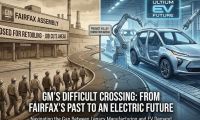There’s something timeless and elemental about a road trip, something that transcends drivetrain layout, fuel source, or whether your car barks through a big-bore exhaust or glides along in hushed Scandinavian composure.

Today’s road warrior doesn’t wrestle carburetors or keep a jug of water for the radiator. Instead, they decipher charging networks and learn to coexist with sentient driving assistants. And in the middle of this evolution sits Polestar, a new marque that’s daring to put some Scandinavian soul back into our increasingly soulless highway miles.
Polestar – Volvo's Answer To Electric Luxury
Polestar isn’t trying to be Tesla, and that’s a good thing. Born from Volvo’s performance skunkworks but with design language lifted straight from the Bauhaus and engineering tighter than a Swede’s bookshelf assembly, the brand is carving its own niche, part minimalist art, part muscle car whisperer. As one intrepid Polestar owner recently discovered during his maiden voyage in the sleek Swedish EV,
“I love this car, but lane change assist overriding me mid-maneuver was a bit shocking, even if it's user error and intended behaviour 😅.”
The driver, having upgraded from a manual 2012 BMW 320D.

Found himself in an entirely new realm where automation and human intuition occasionally clash spectacularly.
“I indicated, took over control of the steering, but midway through the maneuver, the steering assist re-engaged and aggressively made me go back into my original lane.”
The result? A driving lesson disguised as a software quirk. A tale to be told over beers and replays of dashcam footage.
Another Reddit user, 1SlowSupra, had a 1,700-mile crusade from Phoenix to Nashville in his Polestar 2.
“Averaged 27.7 kW usage per 100 miles.
Had no issues using EA up until Van Horn when I started to use only Tesla chargers due to the prices (.25 cents at some Tesla and .64 cents at the EA stations).”
But let’s not pretend the EV road trip is just range anxiety and app-tapping. The Polestar 2, and its newer sibling, the PS4, create something uniquely calming. Inside is a cabin that’s more Scandinavian spa than sports sedan, a clean and quiet space that breeds long, thoughtful conversation between driver and passenger, or total silence, if that’s more your speed.
Polestar Gives You Freedom
And honestly, a lot of the time, it’s boring. Not the kind of boredom that comes from bad design or slow acceleration, both of which the Polestar has smartly avoided, but the old-school, stretch-of-endless-road, where-the-hell-are-we boredom that’s baked into the road trip DNA. You hit hour five, and the scenery starts to bleed together. One diner looks like the next, one lonely gas station merges into another. It’s just you, your machine, and a long straight line into the horizon. There’s a rhythm to it, a steady heartbeat of tires against asphalt, that’s meditative at first, then numbing. It’s not glamorous, it’s not cinematic. It’s boring. And that, paradoxically, is part of the magic.
Polestar 2 Specifications
- The Polestar 2 offers a variety of powertrains. The Long Range Single Motor variant delivers up to 320 miles of EPA-estimated range, while the Long Range Dual Motor version provides approximately 254 miles. For those seeking enhanced performance, the Long Range Dual Motor with Performance Pack accelerates from 0 to 60 mph in just 4.2 seconds, thanks to its 476 horsepower output.
- As one of the first vehicles to feature Google's Android Automotive OS, the Polestar 2 offers seamless integration with Google services like Maps, Assistant, and the Play Store. This system provides real-time updates and voice control, enhancing the driving experience.
- The Polestar 2 stands out with its minimalist Scandinavian design, featuring frameless mirrors, a panoramic glass roof with the Polestar logo, and a unique light sequence that greets the driver upon approach.
Because somewhere deep in that boredom, you forge the real connection, with the car, with the person a few feet away from you, and with your own wandering thoughts. It’s the part of the trip where playlists run out, conversations taper off, and you find yourself humming along to the tire noise. It’s the unglamorous, in-between stuff that makes the arrival sweeter and the memories stickier. The Polestar doesn’t try to hide that fact with gimmicks or distractions. It just gives you a comfortable, graceful place to sit while the world blurs by at 75 mph, waiting for whatever comes next.
When you’ve got 200 miles of nothing between you and the next charger, things get real. You connect with your car, with your roadmate, and with that weird little part of yourself that only shows up after eight hours on the Interstate.
But technology still throws curveballs.
“I did have a minor issue in Texarkana where I was getting an error at the hotel Tesla Destination Chargers AND with my own OEM Cord. Turned off the car and came back 30 minutes later, and it was working fine.”
It’s the new form of roadside troubleshooting. You don’t grab a wrench, you do a hard reboot.
Polestar Is Threading The Needle
And through all of it, Polestar has managed to thread a very tight needle, building cars that feel alive in a world that increasingly wants to make them soulless. The PS4’s styling is assertive without being brash, elegant without resorting to faux luxury tropes.
“Acceleration is shockingly quick, the interior an absolute delight, and it definitely turns heads.”
The road trip is still the crucible in which a car proves itself. Doesn’t matter if it drinks premium unleaded or sips electricity like a monk with a cold brew.
How Polestar Originated
- Polestar originated in 1996 as Flash Engineering, a racing team competing in the Swedish Touring Car Championship. It evolved into Polestar Racing and became Volvo's official performance partner in 2009. In 2015, Volvo acquired Polestar, transforming it into a standalone electric vehicle brand by 2017.
- Polestar is committed to sustainability, exemplified by its Precept concept car, which utilizes innovative materials like flax-based composites and recycled plastics. The company aims to produce a truly carbon-neutral car by 2030 through its "Project 0" initiative.
- Polestar's vehicles are known for their minimalist Scandinavian design and advanced technology. The Polestar 2, for instance, was among the first cars to feature an infotainment system powered by Google's Android Automotive OS, offering seamless integration with Google services.
The Polestar passed the test. It had a few hiccups, sure. But those hiccups are the point. That’s what makes a car more than just transportation. It becomes memory. Identity. A character in your favorite story, the one where the chargers were cheap, the lane changes had a learning curve, and the miles rolled by in quiet, electric bliss.
Noah Washington is an automotive journalist based in Atlanta, Georgia. He enjoys covering the latest news in the automotive industry and conducting reviews on the latest cars. He has been in the automotive industry since 15 years old and has been featured in prominent automotive news sites. You can reach him on X and LinkedIn for tips and to follow his automotive coverage.













Comments
I've been driving my Launch…
Permalink
I've been driving my Launch edition PS2 for three years and love it still. But I'm finding the Tesla chargers to cost more than EA at least on the East Coast without monthly membership plans.
That's awesome!
Permalink
In reply to I've been driving my Launch… by Bone (not verified)
That's awesome!